Topic: Turkmen History
 In an unexpected benefit of the Cold War's end, Russian and American archaeologists say they have discovered an ancient civilization that thrived in Central Asia more than 4,000 years ago, before being lost in the sweep of history.
In an unexpected benefit of the Cold War's end, Russian and American archaeologists say they have discovered an ancient civilization that thrived in Central Asia more than 4,000 years ago, before being lost in the sweep of history. The people of this area, the archaeologists say, built oasis settlements with imposing mud-brick buildings and fortifications. They herded sheep and goats and grew wheat and barley in irrigated fields. They had bronze axes, fine ceramics, alabaster and bone carvings and jewelry of gold and semiprecious stones. They left luxury goods in the graves of an elite class.
The accomplishments of these unknown people in what are now the republics of Turkmenistan and Uzbekistan began to emerge over several decades of excavations by archaeologists of the Soviet Union, who worked diligently but in academic silence behind closed borders.
The surprising scope of society suggested a stage of social and economic development generally regarded as civilization. All that seemed lacking was evidence of number or writing systems.
With the end of the Cold War, American archaeologists have joined the Russians in exploring the region, and now they are reporting that they have found inscriptions showing that these people may have indeed had writing, or at least were experimenting with a form of protowriting around 2300 B.C.
"We are rewriting all the history books about the ancient world because of the new political order in our own time," Fredrik Hiebert, a University of Pennsylvania archaeologist involved in the excavation, said in an interview last week.
In the most recent and provocative discovery, Mr. Hiebert uncovered a small stone object engraved with four or five red-colored symbols or letters that apparently bear no resemblance to any other writing system of the time.
Other scholars agreed that the symbols seemed to be unlike contemporary scripts in Mesopotamia, Iran or the Indus River Valley.
Mr. Hiebert made the discovery last summer in ruins at Annau, a site near the border with Iran and only 13 kilometers (8 miles) from Ashgabat, the capital of Turkmenistan.
He described the findings a week ago at a symposium at the University of Pennsylvania and on Saturday at a conference on language and archaeology at Harvard University.
"You can say we have discovered a new ancient civilization," Mr. Hiebert said.
At the same time, the pyramids of Egypt had been standing for three centuries, power in the Tigris and Euphrates valley was shifting from Sumer to Babylon, and the Chinese had yet to develop writing.
Victor Mair, a specialist in ancient Asian languages and cultures at the University of Pennsylvania, who was not on the research team, said of the inscription, "I definitely think that's writing."
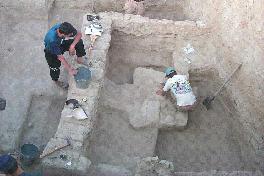 Mr. Mair said that discovery of ruins of an advanced culture in a region "where there was thought to be just space and emptiness fills an enormous gap" in terms of trade and cultural exchange across Asia in antiquity.
Mr. Mair said that discovery of ruins of an advanced culture in a region "where there was thought to be just space and emptiness fills an enormous gap" in terms of trade and cultural exchange across Asia in antiquity. It thus suggested that people in Asia more than 4,000 years ago were not as isolated as once supposed, he said, but probably had continentwide connections.
The dozens of settlement ruins of the newfound civilization stretch east from Annau across the Kara Kum desert into Uzbekistan and perhaps the northern part of Afghanistan.
It is an area 500 to 650 kilometers long and 80 kilometers wide. Archaeologists have given the culture the prosaic name of the Bactria Margiana Archaeology Complex, or BMAC, after the ancient Greek names of two regions it encompasses.
Long after the ruins were buried in sand, the area was traversed by the legendary Silk Road, the caravan route linking China and the Mediterranean lands from the second century B.C. to 1700.
The oases that served as way stations for rest and resupply on the Silk Road also supported the BMAC civilization, which presumably was trading far and wide over some kind of ancestral Bronze Age Silk Road.
Carl Lamberg-Karlovsky, a Harvard archaeologist, questioned whether the symbols on the artifact represented true writing. But he said that Mr. Hiebert's discovery "falls into place with other research showing that this culture was working out some sort of communication system, though it never reached the level of complexity in writing as its neighbors did."
Until the waning days of the Soviet Union, foreign scholars knew almost nothing of the nature and extent of the BMAC culture. Reports of findings were confined to Soviet journals.
In the post-Cold War openness, Russian archaeologists are eagerly sharing their knowledge and inviting collaboration with Westerners.
Victor Sarianidi, of the Institute of Archaeology in Moscow, found a distinctive architectural pattern in many of the ruins. The buildings at each site appeared to be erected in one burst of construction according to the design of a single architect.
The largest buildings were like large apartment complexes, divided into dozens and dozens of rooms.
They were surrounded by multiple mud-brick walls, some as much as 3 meters (10 feet) thick. Beyond lay traces of agricultural fields.
Mr. Hiebert plans to return to Annau, possibly next month, for further excavations to be financed in part by the National Geographic Society.
13.05.2001
John Nobel Wilford
Source: The New York Times
Posted by countryturkmenistan
at 5:51 PM
Updated: Tuesday, 31 May 2005 5:56 PM

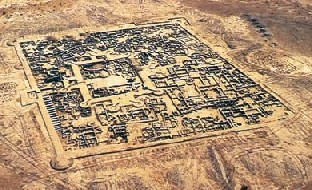 A new book by well-known Russian archaeologist Victor Sarianidi about excavations in the ancient country of Margush is published in Turkmenistan
A new book by well-known Russian archaeologist Victor Sarianidi about excavations in the ancient country of Margush is published in Turkmenistan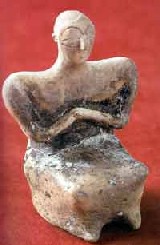 We were lucky to open the tsar’s funeral complex where you can find not only the defunct but also symbols of statehood as well: stone scepters that were used as an attribute of power in ancient times; pictures of eagles in the golden cover, golden and silver vessels, traces of rich sacrifices, mosaic on walls and hearses that still has no analogy in Central Asia. Moreover, several true masterpieces of the ancient jewellery art feature among the masses of findings. First of all, it is a small sculpture of djeiran made of gold and a sculpture of a lion cub turned in turquoise. Their size is less than a centimeter but you can see all the details of the amazing works of ancient masters of Turkmenistan through magnifying lens. The works merit being included into the Guinness Book of Records. I hope that these masterpieces will be soon displayed in the new Museum of Fine Arts in Ashgabat for they represent the earliest pieces of the art of ancestors of the Turkmen people.
We were lucky to open the tsar’s funeral complex where you can find not only the defunct but also symbols of statehood as well: stone scepters that were used as an attribute of power in ancient times; pictures of eagles in the golden cover, golden and silver vessels, traces of rich sacrifices, mosaic on walls and hearses that still has no analogy in Central Asia. Moreover, several true masterpieces of the ancient jewellery art feature among the masses of findings. First of all, it is a small sculpture of djeiran made of gold and a sculpture of a lion cub turned in turquoise. Their size is less than a centimeter but you can see all the details of the amazing works of ancient masters of Turkmenistan through magnifying lens. The works merit being included into the Guinness Book of Records. I hope that these masterpieces will be soon displayed in the new Museum of Fine Arts in Ashgabat for they represent the earliest pieces of the art of ancestors of the Turkmen people.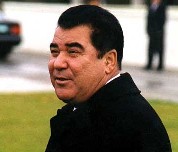 Saparmurat Niyazov was born on February 19, 1940, into a worker's family in Ashgabat. His father died in battle in World War II and the remaining members of his family perished in Ashgabat's massive earthquake of 1948. He was raised first in an orphanage and later in the home of his distant relatives.
Saparmurat Niyazov was born on February 19, 1940, into a worker's family in Ashgabat. His father died in battle in World War II and the remaining members of his family perished in Ashgabat's massive earthquake of 1948. He was raised first in an orphanage and later in the home of his distant relatives. 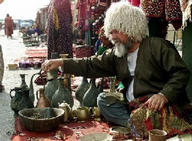 Turkmenistan, located in the southern most part of the former Soviet Union, is rich in tradition, culture and natural beauty. A small country of five million people, Turkmenistan shares it's boarder with Iran in the south, Afghanistan to the east, Uzbekistan in the north and the Caspian Sea to the west. Hundreds of years ago the territory now known as Turkmenistan linked great civilizations together from the East and West along the great Silk Road. Today you can see much of the same people living here preserving their traditions, culture and heritage.
Turkmenistan, located in the southern most part of the former Soviet Union, is rich in tradition, culture and natural beauty. A small country of five million people, Turkmenistan shares it's boarder with Iran in the south, Afghanistan to the east, Uzbekistan in the north and the Caspian Sea to the west. Hundreds of years ago the territory now known as Turkmenistan linked great civilizations together from the East and West along the great Silk Road. Today you can see much of the same people living here preserving their traditions, culture and heritage.  On their route the towns of Samarkand, Bukhara, Khiva, Merv and Kunya-Urgench played important stops for the caravans. Caravans from Merv started for Serags, Nishapur (Iran), Abiverd, Nissa, Dekhistan, then continued along the coast of the Caspian Sea heading towards Turkey. These towns are full of mystery and superstition. The ancient town of Kunya-Urgench is said to have been destroyed seven times, each time resurrecting itself like a phoenix out of ashes. In the middle of the XIV century Husein Sufi, a Turkmen from Kungrad, founded a dynasty here ruling up until the raids of Tamerlan's military.
On their route the towns of Samarkand, Bukhara, Khiva, Merv and Kunya-Urgench played important stops for the caravans. Caravans from Merv started for Serags, Nishapur (Iran), Abiverd, Nissa, Dekhistan, then continued along the coast of the Caspian Sea heading towards Turkey. These towns are full of mystery and superstition. The ancient town of Kunya-Urgench is said to have been destroyed seven times, each time resurrecting itself like a phoenix out of ashes. In the middle of the XIV century Husein Sufi, a Turkmen from Kungrad, founded a dynasty here ruling up until the raids of Tamerlan's military. 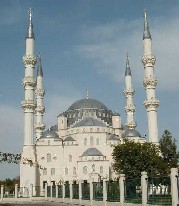 The Turkmen people once known as some of the fiercest warriors, helping and aiding the likes of Kangus Kan and Alexander the Great, will only kill you with kindness. They are some of the friendliest people on the Silk Road with their diversity, humor and superstitions. As a visitor you'll be asked in their homes for tea, or even join in as a part of a family wedding. You'll share with them their holy shrines, and traditional "Tamdyr" bread, still made the same way as hundreds of years ago. Bargain with the colorfully dressed women at the bazaars while talking with "Yash-olies" or holy men at a horserace. Traditions like carpet making, weaving, embroidery and jewelry making still can be seen and observed all in a day.
The Turkmen people once known as some of the fiercest warriors, helping and aiding the likes of Kangus Kan and Alexander the Great, will only kill you with kindness. They are some of the friendliest people on the Silk Road with their diversity, humor and superstitions. As a visitor you'll be asked in their homes for tea, or even join in as a part of a family wedding. You'll share with them their holy shrines, and traditional "Tamdyr" bread, still made the same way as hundreds of years ago. Bargain with the colorfully dressed women at the bazaars while talking with "Yash-olies" or holy men at a horserace. Traditions like carpet making, weaving, embroidery and jewelry making still can be seen and observed all in a day.  Both hosts and guests should get ready to the ritual meal beforehand. The guest foretastes the forthcoming feast and eats nothing to maintain the appetite strong. The hosts’ concerns are much greater. The whole process of preparing “kelle-bashayak” takes five to six hours. By the way,ankly speaking, it is accuracy and duration of cooking this meal that make it possible to call it a dish for the guest of honour. In this situation, the host’s respect for the guest is shown not by the richness of the table, but by the diligence and patience in the process of its preparation.
Both hosts and guests should get ready to the ritual meal beforehand. The guest foretastes the forthcoming feast and eats nothing to maintain the appetite strong. The hosts’ concerns are much greater. The whole process of preparing “kelle-bashayak” takes five to six hours. By the way,ankly speaking, it is accuracy and duration of cooking this meal that make it possible to call it a dish for the guest of honour. In this situation, the host’s respect for the guest is shown not by the richness of the table, but by the diligence and patience in the process of its preparation. 